
|
|
|
|
|
|
|
|
|
|
|
|
|
|
|
Gardener’s Delight
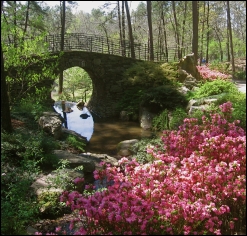 |
||
By Lisa Perry
If you are a garden enthusiast, or if you
just like to walk through the woods, then you would surely
enjoy a trip to Garvin Woodlands Garden in Hot Springs. The
garden features 210 acres of woodland gardens and is surrounded
by four and a half miles of beautiful Lake Hamilton. It was
built upon the vision of Verna C. Garvin who donated the
property to the University of Arkansas in1985. Since then it
has grown into a respected botanical garden, and it continues
to grow with new areas and buildings expanding the
possibilities for exploration.
There are numerous trails throughout the
garden that provide for a pleasant stroll and viewing. The
Garden of the Pinewoods features over 60 types of Japanese and
other Asian maples as well as hydrangeas, azaleas, Oriental
dogwoods, cedars, and viburnums. There are several bridges,
including the Sunset Bridge and the Full Moon Bridge, which
offer views overlooking the stream that cascades throughout
this area and culminates in a 12 foot waterfall and reflecting
pond with multicolored koi.
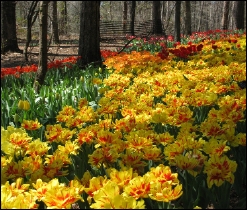 |
||
Warren’s Woodland Walk is a mile
long path past some more seasonal plantings nestled beneath the
canopy of oak, hickory, pine and ash trees. Caladiums,
impatiens, coleus, angelwing begonias, and bloodleaf are some
of the annuals that line the walkway for summer color.
Camellias, abelias, hostas, oakleaf hydrangeas, ferns, native
grasses, and wildflowers such as coreopsis, echinacea, and
oxeye daisy are spread throughout the garden.
Side paths are available to wander
through the forest and down to views of the lake and
surrounding mountains. Fragrances of jasmine, honeysuckle,
native azaleas, or sweet olive trees float on the breeze when
they are in bloom. Numerous birds may be heard or seen such as
woodpeckers, herons, hummingbirds, kingfishers, swifts, ducks,
geese, and grebes.
The sound of the Singing Springs can also
be heard as it falls gracefully down the side of the
embankment. There are stepping stones that meander beside it
and allow for close observation or photographs at various
levels. And there is a lovely overview of the springs from the
Millsap Canopy Bridge.
The Hixson Family Nature Preserve
provides another pathway over the Lowland Boardwalk near the
lake’s edge. It is a great place to view water birds and
then continue on the one mile trail through the 45 acres of pin
oak, water oak, gum, cypress trees and native plants. It offers
numerous vistas of Lake Hamilton, occasional benches for
resting or soaking in the natural setting, as well as 75
species of birds and another natural spring.
Future expansions for the garden include
the Evans Children’s Adventure Garden which will be
viewed from the 450 foot long, 20 foot tall access bridge. A
new rose garden is also in progress and promises to be a rose
lover’s delight.
There are many other attractions in the
garden including Anthony Chapel with its 60 foot high roof and
glass walls, the Evans Celebration Garden, which compliments
the chapel, the Anthony Family Carillon, the Weyerhaeuser
Bonsai Garden, and the Model Train Garden.
This time of year the garden is open
seven days a week from 9:00 a.m. to 6:00 p.m. It is
located at 550 Arkridge Rd. which is just off Carpenter Dam
Road in Hot Springs. Admission is $8 for adults, $7 for seniors
(55+), $4 for children 6-12 years old, and children under 5
years of age get in free. Golf cart tours are offered for an
additional fee. There are memberships to the garden available
also, and they can be reached at 501-262-9300 or 800-366-4664
or www.garvingardens.org.
A Florida Garden in Arkansas
By Lisa Perry
After living in Arkansas for twenty some
odd years, we moved to Central Florida to set up residence
there. I had been fortunate enough to have had a number of
friends here in Arkansas who had “set me on the gardening
path,” and who had shared a great deal of their knowledge
of plants and the art of garden maintenance. I even thought
that I had learned a few things and had a fair bit of knowledge
“under my belt.” I was ready, willing and
enthusiastic about moving forward on my garden there, and I did
proceed to plant as much and as fast as I could. However,
it didn’t take long for me to realize that gardening in
Florida was a “whole new ballgame,” and that it was
almost like being on an entirely different planet! Even the
plants that I had grown to know and love here behaved in a
completely different manner there. Things that loved sun here
might need shade there, and things that loved shade here might
want sun there! Things that needed lots of water here might not
need much there, and visa versa. There didn’t seem to be
much rhyme or reason about it, so I did a lot of research and
asked a lot of people a lot of questions to try to monitor and
adjust myself to the different kinds of dirt, climate, and
thriving plant varieties. And I am happy to say that through
the research, and a bit of trial and error, I had a modicum of
success.
So, about a year and a half ago, when I
moved back to Arkansas, I set about readjusting myself to the
set of gardening “rules” that apply here, and to
“unlearn” what I had learned in Florida and to
“re-learn” what I had
“unlearned.” But I also wanted to bring back
the knowledge and the cultivation of some different plant
varieties that I had come to love there. I was pleased to find
out that I could find a number of them here in the local plant
nurseries, and that they could be successfully grown here under
the right conditions and if I had a place inside for them to
spend the winter. I even accidentally left some of them
in the ground over the winter and thought that would be their
untimely demise only to find that they returned in the spring,
still happy and ready to grow again.
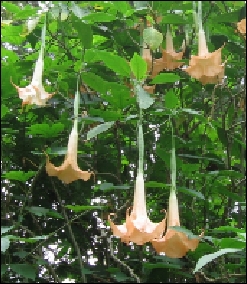 |
||
One of my favorites is datura or
angel’s trumpet. It can grow into a small tree size in
Florida, which mine did, but it is best kept in a large pot
here in Arkansas. It does like a lot of sun, but it can take a
bit shade. The foliage is soft, tender, elliptic and large and
has a delicate nature that requires a lot of water. It can have
a tendency to wilt if it doesn’t get enough water, and it
seems to also desire a good amount of food in order to keep
blooming. I like a color booster and a time release food to
keep the blooms coming throughout our warm season. It has the
habit to bloom in “flushes,” which means there are
numerous blooms and then a period of no blooms, and then
another period of blooms in a couple of weeks. The blooms are
wonderful nine inch long trumpet shaped, delicately fragranced
flowers that hang downward. I have some that are peach, some
that are yellow, and I have also seen white varieties. Mine are
all growing in tree form, but I have seen them pruned to have
numerous branches and a fuller shape. All daturas are very
poisonous, so you would need to keep that in mind if you have
small children around. They can be propagated easily from
cuttings and seeds, and they do need to be protected from the
cold here in winter. They are well worth the trouble if you
like large flowers and a sweet smell, and they will bloom
repeatedly throughout the warm season.
Another one of my favorites is Phaius
grandiflorus, or the nun’s cap orchid. This one, unlike
most orchids, is a terrestrial instead of an epiphyte. That
means it grows in the dirt instead of being an air plant that
generally grows in trees. This one spreads profusely in the
Florida forests, where it can take on a wild, native quality.
Here in Arkansas, however, it needs to be grown in a pot and
protected against the cold weather. I wouldn’t expose
mine to anything less than 35
degrees F, but I have seen information on
the internet claiming it has been left out in down to 20 degree
F weather. It has medium colored, large foliage that grows
straight up out of the ground. It sends up 10 – 15 inch
stalks in late winter to early spring that bloom numerous small
maroon, white, and yellow orchid shaped flowers that last for
weeks. It is a lovely plant that needs to be kept in the
shade when it is out in the garden. I try not to let it get too
dry, but it doesn’t like to be too wet either. Other than
the protection form the cold, it is a fairly easy care and
highly rewarding plant.
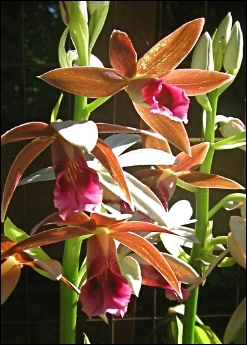 |
||
I am sure that most of you have noticed
the numerous tropical hibiscus varieties available here. This
is a great, showy, evergreen shrub with lush, dark green
foliage and large, bright, colorful blooms. They are pretty
disease resistant overall, but they do like regular watering
and lots of food to keep them blooming. Once again, they
have a habit of blooming in flushes, so there will be
periods when they have lots of blooms, and periods when they
may not have any. They will bloom repeatedly, though,
throughout the summer if kept well fed, and the choices of
colors and blooms are numerous. Some have the traditional,
single layered flowers, while others have a double layered
bloom that gives them more of a spherical shaped quality. Red,
orange, yellow, peach, coral and multicolored varieties are
available. They are sold as annuals here, but if you keep them
warm during the winter season, they will stay green and be
ready to bloom again next spring. They like it hot and in the
sun. They can take some shade, but probably won’t bloom
as well as if they were in the sun. They work great on the
patio or out in the flower beds.
The Australian tree fern is another
tropical that is well worth the minimal extra effort required.
As a member of the Cyatheaceae family, these single, brown,
furry trunks support large, feather-leaved fronds of lacy fern
foliage. In the tropics and sub-tropics they can grow to be 20
feet tall with multiple fronds cascading overhead. Here in
Central Arkansas they are best grown in containers in a deep
shaded area. Their delicate foliage is easily burned with too
much sun, and they require consistent watering to keep them
moist. They also like the humid tropical air, so misting or
watering the leaves regularly is a good
practice. They do not like fertilizer
sprayed on their leaves, however, and whole fronds will turn
brown and die back in response to that. They can be lightly
fertilized on the roots with a water soluble fertilizer or a
mild time release granular fertilizer. There are no flowers,
but the lush foliage is rewarding enough. They cannot tolerate
cold temperatures, so they must be moved to a protected, warm
area inside as soon as temperatures start dropping near
freezing.There are a number of other plants that I learned
about in Florida, and I will write more about them in later
articles. In the meantime, these are some fairly low
maintenance plants that are very rewarding and give the garden
some variety as well as a tropical flair. Happy planting.
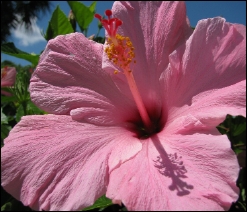 |
||
NOTE: Mexican petunia, Australian
tree fern, Nun’s cap orchids, Gingers, Hibiscus, Golden
daisy shrub, Shrimp plant, Bromeliads, Schefalara, Norfolk
Island pine, Fiddle leaf fig, Rubber plant, Ti plant.